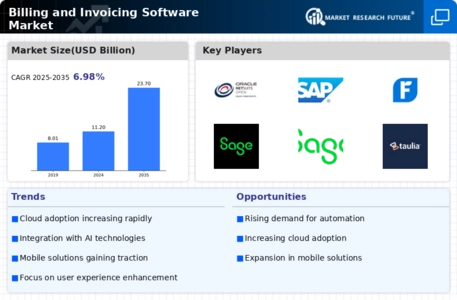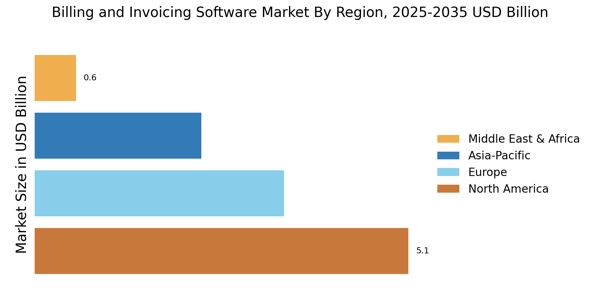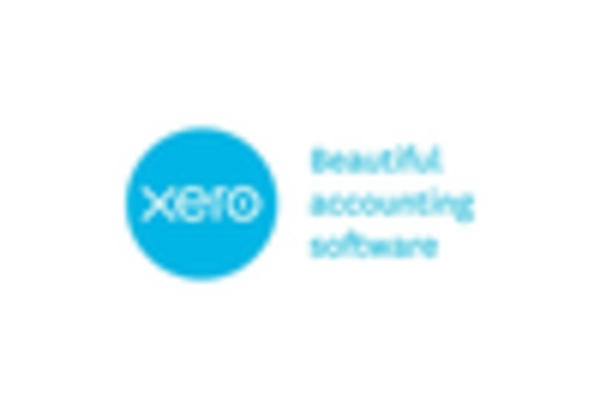Expansion of Small and Medium Enterprises
The Billing and Invoicing Software Market is significantly influenced by the expansion of small and medium enterprises (SMEs). As these businesses proliferate, there is a corresponding need for efficient financial management tools. Recent statistics reveal that SMEs account for a substantial portion of employment and economic activity, underscoring their importance in the market. Many SMEs are seeking cost-effective billing and invoicing solutions that can scale with their growth. This trend indicates a potential market opportunity for software providers that cater specifically to the needs of smaller businesses. By offering tailored solutions that address the unique challenges faced by SMEs, companies can position themselves favorably within the competitive landscape of the billing and invoicing software market.
Growing Importance of Customer Experience
The Billing and Invoicing Software Market is increasingly recognizing the growing importance of customer experience. Businesses are striving to enhance their interactions with clients, and billing processes are a critical touchpoint in this journey. Software solutions that prioritize user-friendly interfaces and seamless integration with existing systems are becoming more desirable. Data suggests that companies that invest in improving customer experience can see significant returns in customer loyalty and retention. As organizations seek to differentiate themselves in a crowded marketplace, those that offer intuitive and efficient billing and invoicing solutions are likely to attract and retain more clients. This trend indicates a shift towards customer-centric software development, which may redefine competitive dynamics in the industry.
Increased Focus on Financial Transparency
In the current landscape, the Billing and Invoicing Software Market is witnessing an increased emphasis on financial transparency. Organizations are recognizing the importance of clear and accurate financial reporting, which is essential for building trust with stakeholders. This shift is reflected in the growing adoption of software solutions that offer real-time reporting and analytics capabilities. Data indicates that businesses utilizing advanced billing and invoicing systems can reduce discrepancies and improve cash flow management. As regulatory requirements become more stringent, the demand for software that ensures compliance and provides detailed financial insights is likely to rise. This trend suggests that companies prioritizing transparency in their financial dealings may enhance their operational efficiency and stakeholder relationships.
Rising Demand for Digital Payment Solutions
The Billing and Invoicing Software Market is experiencing a notable surge in demand for digital payment solutions. As businesses increasingly transition to online platforms, the need for efficient and secure payment processing becomes paramount. According to recent data, the digital payment sector is projected to grow at a compound annual growth rate of over 12% in the coming years. This trend is driven by consumer preferences for convenience and speed in transactions. Consequently, billing and invoicing software that integrates seamlessly with various payment gateways is likely to gain traction. Companies that offer comprehensive solutions that cater to this demand may find themselves at a competitive advantage, as they can provide clients with the tools necessary to streamline their financial operations.
Technological Advancements in Software Development
Technological advancements are playing a crucial role in shaping the Billing and Invoicing Software Market. Innovations such as artificial intelligence, machine learning, and blockchain technology are being integrated into billing solutions, enhancing their functionality and security. For instance, AI-driven analytics can provide businesses with insights into customer behavior and payment patterns, allowing for more informed decision-making. Furthermore, the incorporation of blockchain technology can improve transaction security and reduce fraud risks. As these technologies continue to evolve, they are likely to drive the demand for more sophisticated billing and invoicing solutions. Companies that leverage these advancements may gain a competitive edge, as they can offer enhanced features that meet the evolving needs of their clients.


















Leave a Comment